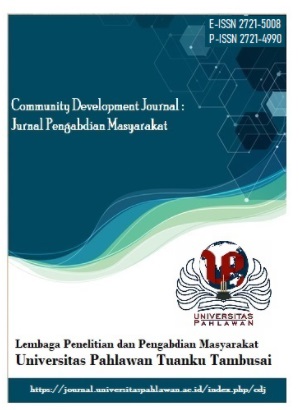PENGEMBANGAN MEDIA PEMBELAJARAN BERBASIS SIMULASI EFEK FOTOLISTRIK UNTUK MEMAHAMI FENOMENA KUANTUM
DOI:
https://doi.org/10.31004/jrpp.v7i4.38241Keywords:
Efek Fotolistrik, Fisika Kuantum, Simulasi Phet, Media Pembelajaran, Pemahaman Konsep.Abstract
Efek fotolistrik adalah konsep penting dalam fisika fisika yang sering dianggap abstrak oleh mahasiswa. Penelitian ini bertujuan efektivitas simulasi berbasis PhET dalam meningkatkan pemahaman siswa terhadap fenomena ini. Metode penelitian deskriptif kuantitatif digunakan, melibatkan lima mahasiswa pendidikan fisika angkatan 2020 dan 2021. Penelitian meliputi wawancara awal, pre-test, pemberian simulasi, dan post-test. Hasil pre-test menunjukkan pemahaman awal yang rendah dengan skor rata-rata 28 dari 100. Setelah simulasi PhET, nilai post-test meningkat signifikan menjadi rata-rata 57. Simulasi ini membantu siswa memahami hubungan antarvariabel seperti frekuensi cahaya dan energi kinetik elektron. Penelitian ini menyimpulkan bahwa simulasi PhET efektif sebagai media pembelajaran inovatif untuk meningkatkan pemahaman konsep abstrak dalam fisika fisika.References
Anwar, Y., Susanti, R., & Ermayanti. (2019). Analyzing scientific argumentation skills of biology education students in General Biology Courses. Journal of Physics: Conference Series, 1166, 012001. https://doi.org/10.1088/1742-6596/1166/1/012001
Anwar, K., Isnaini, M., & Utami, L. S. (2018). Eksperimen efek foto listrik berbasis simulasi PhET. Paedagoria: Jurnal Kajian, Penelitian Dan Pengembangan Kependidikan, 4(2), 9-15.
Asyhari, A., Irwandani, I., & Saputra, H. C. (2016). Lembar Kerja instruksi Konseptual Berbasis Phet: Mengembangkan bahan ajar untuk mengkonstruksi KONSEP Siswa Pada Efek Fotolistrik. Jurnal Ilmiah Pendidikan Fisika Al-Biruni, 5(2), 193–204. https://doi.org/10.24042/jpifalbiruni.v5i2.119
Cahyaningrum, R. (2019). Lawson Instrument: Analyzing Student’s scientific reasoning skill in junior high school. Proceedings of the 6th International Conference on Community Development (ICCD 2019). https://doi.org/10.2991/iccd-19.2019.116
Cheong, Y. W., & Song, J. (2024). University Students’ understanding of the behavior of light and their reasoning to the particle-like nature of light in the photoelectric effect. New Physics: Sae Mulli, 74(3), 326–336. https://doi.org/10.3938/npsm.74.326
Dewa, E., Ama Ki`i, O., & Pasaribu, R. (2023). Penggunaan simulasi Phet Dan E-evaluation berbasis hot-potatoes untuk MENINGKATKAN Pemahaman KONSEP Efek fotolistrik Dan Minat belajar Calon Guru fisika. ORBITA: Jurnal Pendidikan Dan Ilmu Fisika, 9(1),79. https://doi.org/10.31764/orbita.v9i1.14787
Habibbulloh, M., Jatmiko, B., & Widodo, W. (2017). Pengembangan Perangkat pembelajaran model guided discovery berbasis lab virtual Untuk Mereduksi Miskonsepsi Siswa SMK Topik Efek Fotolistrik. Jurnal Penelitian Fisika Dan Aplikasinya (JPFA), 7(1), 27. https://doi.org/10.26740/jpfa.v7n1.p27-43
Mandagi, A. F., Iswanto, B. H., & Sugihartono, I. (2021). Virtual microscopic simulation (VMS) for physics learning of the photoelectric effect in high school. Journal of Physics: Conference Series, 2019(1), 012013. https://doi.org/10.1088/1742-6596/2019/1/012013
McKagan, S. B., Perkins, K. K., Dubson, M., Malley, C., Reid, S., LeMaster, R., & Wieman, C. E. (2008). Developing and researching Phet simulations for teaching quantum mechanics. American Journal of Physics, 76(4), 406–417. https://doi.org/10.1119/1.2885199
Putri, M. D., & Rusdiana, D. (2017). Identifying students’ scientific argumentation skill at junior high school 1 ARGAMAKMUR, North Bengkulu. IJAEDU- International E-Journal of Advances in Education, 556–572. https://doi.org/10.18768/ijaedu.370424
Saregar, A. (2016). Pembelajaran Pengantar Fisika Kuantum Dengan memanfaatkan media Phet Simulation Dan LKM Melalui Pendekatan Saintifik: Dampak Pada Minat dan penguasaan Konsep Mahasiswa. Jurnal Ilmiah Pendidikan Fisika Al-Biruni, 5(1), 53–60. https://doi.org/10.24042/jpifalbiruni.v5i1.105
Sokolowski, A. (2012). Teaching the photoelectric effect inductively. Physics Education, 48(1), 35–41. https://doi.org/10.1088/0031-9120/48/1/35
Supurwoko, S., Cari, C., Sarwanto, S., Sukarmin, S., Budiharti, R., & Dewi, T. S. (2017a). Virtual lab experiment: Physics educational technology (phet) photo electric effect for senior high school. International Journal of Science and Applied Science: Conference Series, 2(1), 381. https://doi.org/10.20961/ijsascs.v2i1.16750
Supurwoko, S., Cari, C., Sarwanto, S., Sukarmin, S., Budiharti, R., & Dewi, T. S. (2017b). Virtual lab experiment: Physics educational technology (phet)photo electric effect for senior high school. International Journal of Science and Applied Science: Conference Series, 2(1), 381. https://doi.org/10.20961/ijsascs.v2i1.16750
Tarng, W., Lee, C., Lin, C., & Chen, W. (2018). Applications of virtual reality in learning the photoelectric effect of liquid crystal display. Computer Applications in Engineering Education, 26(6), 1956–1967. https://doi.org/10.1002/cae.21957
Downloads
Published
How to Cite
Issue
Section
License
Copyright (c) 2024 Fadila Mutia Srg, Feri Waluyo, Lisa Febriani, Maysha Syakila

This work is licensed under a Creative Commons Attribution-ShareAlike 4.0 International License.






